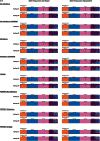An overview of STRUCTURE: applications, parameter settings, and supporting software
- PMID: 23755071
- PMCID: PMC3665925
- DOI: 10.3389/fgene.2013.00098
An overview of STRUCTURE: applications, parameter settings, and supporting software
Abstract
Objectives: We present an up-to-date review of STRUCTURE software: one of the most widely used population analysis tools that allows researchers to assess patterns of genetic structure in a set of samples. STRUCTURE can identify subsets of the whole sample by detecting allele frequency differences within the data and can assign individuals to those sub-populations based on analysis of likelihoods. The review covers STRUCTURE's most commonly used ancestry and frequency models, plus an overview of the main applications of the software in human genetics including case-control association studies (CCAS), population genetics, and forensic analysis. The review is accompanied by supplementary material providing a step-by-step guide to running STRUCTURE.
Methods: With reference to a worked example, we explore the effects of changing the principal analysis parameters on STRUCTURE results when analyzing a uniform set of human genetic data. Use of the supporting software: CLUMPP and distruct is detailed and we provide an overview and worked example of STRAT software, applicable to CCAS.
Conclusion: The guide offers a simplified view of how STRUCTURE, CLUMPP, distruct, and STRAT can be applied to provide researchers with an informed choice of parameter settings and supporting software when analyzing their own genetic data.
Keywords: CLUMPP; STRAT; STRUCTURE; case-control association studies; distruct; population structure; stratification.
Figures


Similar articles
-
pophelper: an R package and web app to analyse and visualize population structure.Mol Ecol Resour. 2017 Jan;17(1):27-32. doi: 10.1111/1755-0998.12509. Epub 2016 Feb 26. Mol Ecol Resour. 2017. PMID: 26850166
-
Inference of Ancestry in Forensic Analysis II: Analysis of Genetic Data.Methods Mol Biol. 2016;1420:255-85. doi: 10.1007/978-1-4939-3597-0_19. Methods Mol Biol. 2016. PMID: 27259745
-
Testing for association in the presence of population stratification: a simulation study comparing the S-TDT, STRAT and the GC.Biom J. 2006 Jun;48(3):420-34. doi: 10.1002/bimj.200410214. Biom J. 2006. PMID: 16845906
-
Softwares and methods for estimating genetic ancestry in human populations.Hum Genomics. 2013 Jan 5;7(1):1. doi: 10.1186/1479-7364-7-1. Hum Genomics. 2013. PMID: 23289408 Free PMC article. Review.
-
From cheminformatics to structure-based design: Web services and desktop applications based on the NAOMI library.J Biotechnol. 2017 Nov 10;261:207-214. doi: 10.1016/j.jbiotec.2017.06.004. Epub 2017 Jun 11. J Biotechnol. 2017. PMID: 28610996 Review.
Cited by
-
Population genetic structure and ecological differentiation in the bryozoan genus Reteporella across the Azores Archipelago (central North Atlantic).Heliyon. 2024 Oct 1;10(19):e38765. doi: 10.1016/j.heliyon.2024.e38765. eCollection 2024 Oct 15. Heliyon. 2024. PMID: 39430515 Free PMC article.
-
Genetic diversity and population structure of endangered plant species Anagallis foemina Mill. [Lysimachia foemina (Mill.) U. Manns & Anderb.].Physiol Mol Biol Plants. 2020 Aug;26(8):1675-1683. doi: 10.1007/s12298-020-00839-6. Epub 2020 Jul 7. Physiol Mol Biol Plants. 2020. PMID: 32801495 Free PMC article.
-
Genetic diversity of 21 experimental chicken lines with diverse origins and genetic backgrounds.Exp Anim. 2019 May 8;68(2):177-193. doi: 10.1538/expanim.18-0139. Epub 2018 Dec 13. Exp Anim. 2019. PMID: 30542001 Free PMC article.
-
Moths passing in the night: Phenological and genomic divergences within a forest pest complex.Evol Appl. 2022 Jan 11;15(1):166-180. doi: 10.1111/eva.13338. eCollection 2022 Jan. Evol Appl. 2022. PMID: 35126654 Free PMC article.
-
How methodological changes have influenced our understanding of population structure in threatened species: insights from tiger populations across India.Philos Trans R Soc Lond B Biol Sci. 2022 Jun 6;377(1852):20200418. doi: 10.1098/rstb.2020.0418. Epub 2022 Apr 18. Philos Trans R Soc Lond B Biol Sci. 2022. PMID: 35430878 Free PMC article. Review.
References
LinkOut - more resources
Full Text Sources
Other Literature Sources

